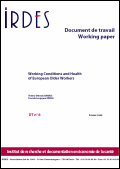
WORKING PAPERS 2011
WP n° 42
|
WP n° 41
|
|
WP n° 40
This research uses a time-based approach of the causal relationship (Granger-like) between health and social capital for older people in Europe. We use panel data from waves 1 and 2 of SHARE (the Survey of Health, Ageing, and Retirement in Europe) for the analysis. Additional wave 3 data on retrospective life histories (SHARELIFE) are used to model the initial conditions in the model. For each of the first 2 waves, a dummy variable for involvement in social activities (voluntary associations, church, social clubs, etc.) is used as a proxy for social capital as involvement in Putnamesque associations; and seven health dichotomous variables are retained, covering a wide range of physical and mental health measures. A bivariate recursive Probit model is used to simultaneously investigate (i) the influence of baseline social capital on current health - controlling for baseline health and other current covariates, and (ii) the impact of baseline health on current participation in social activities - controlling for baseline social capital and other current covariates. As expected, we account for a reversed causal effect: individual social capital has a causal beneficial impact on health and vice versa. However, the effect of health on social capital appears to be significantly higher than the social capital effect on health. These results indicate that the sub-population reaching 50 years old in good health has a higher propensity to take part in social activities and to benefit from it (social support, etc.). Conversely, the other part of the population in poor health at 50, may see its health worsening faster because of the missing beneficial effect of social capital. Social capital may therefore be a potential vector of health inequalities. |
WP n° 39
|
|
WP n° 38
The French pattern of early transitions out of employment is basically explained by the low age at “normal” retirement and by the importance of transitions through unemployment insurance and early-retirement schemes before access to normal retirement. These routes have exempted French workers from massively relying on disability motives for early exits, contrarily to the situation that prevails in some other countries where normal ages are high, unemployment benefits low and early-retirement schemes almost non-existent. Yet the role of disability remains interesting to examine in the French case, at least for prospective reasons in a context of decreasing generosity of other programs. |


